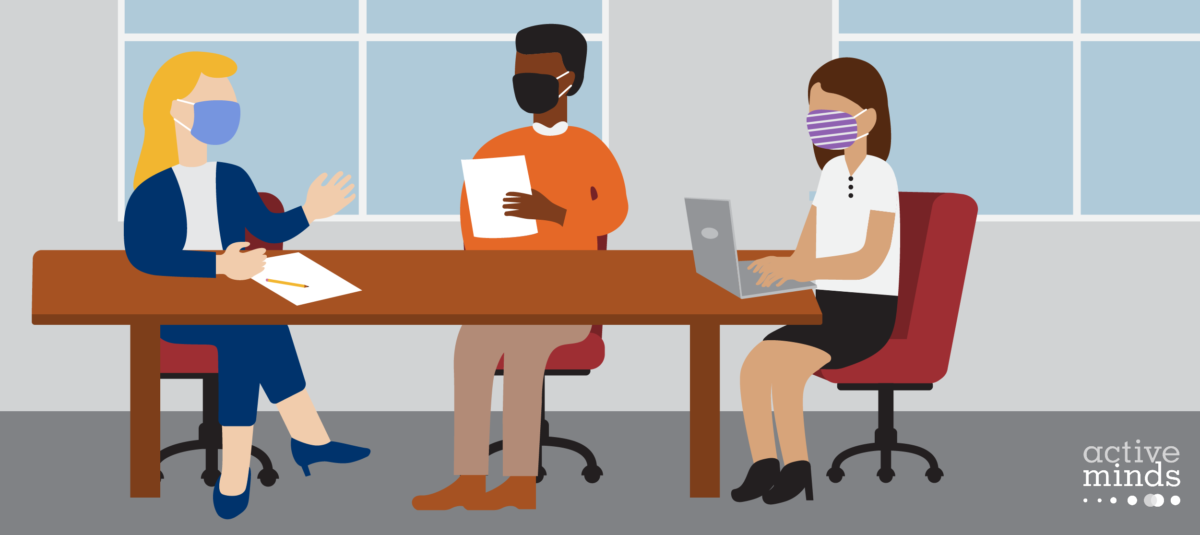Employees across the country are experiencing mixed emotions regarding their expectations of returning to the office. A recent survey reports that 49% of employees anticipate that returning to the office will have a negative impact on their mental health. Without a clear end to the pandemic in sight, many working professionals are feeling uneasy about the future of their work environments. We applaud companies and organizations that are embracing this opportunity to open up conversations about mental wellbeing in the workplace.
There is a lot that may be coming to mind for working professionals who are anticipating a return to the office: commuting, work-life-family balance, childcare or exposure risk. The list may be long. Some may be eager to return to an office environment, and others may be anxious or concerned.
Know that whatever you may be feeling about the return to the office (or continued remote work) is valid, especially considering the ongoing pandemic-related unknowns and stressors. Resources like our Life at Your Pace hub can be helpful in finding ways to re-adjust to in-person work, and manage lingering feelings of apprehension and stress.
No matter what your company’s plans are though, employee mental health should remain a top priority. The pandemic has likely had a significant impact on employees whether they had a previous history of mental health challenges or not.
Here are some strategies to cultivate a more positive and supportive work environment, for both remote and in-person teams.
For employees
- Advocate for your needs. Employees generally have the right to reasonable accommodations as long as those accommodations do not result in significant cost or change to the company. Request any special accommodations or flexibility sooner rather than later so that you are set up for success from day one.
- Explore available resources. If you are new to the team since the pandemic began, ask about what mental health support will look like moving forward.
- Plan ahead. If you have never worked in-person for your employer, request time with your supervisor to discuss office best practices, norms, and expectations. Plan out your new routine and any new adjustments you need to make to your schedule.
- Replicate any home-office comforts or routines such as daily walks, plants at your desk, or stretching breaks.
- Establish boundaries with your co-workers. Don’t be afraid to speak up about what physical interactions you do and do not feel comfortable with (for example, propose an office norm to forgo handshakes and hugs for the time being).
For employers and managers
- Get curious. Ask employees what they need for a successful and comfortable transition back to the office.
- Prioritize safety and health. Implement rotating schedules, physical distancing, masks, ventilation, etc.
- Be open. Let your employees know that it is okay and safe to disclose (or not disclose) a mental health challenge at work, and create the space for your employees to ask for help.
- Get creative. Host interactive team get-togethers, either remote or in-person, such as small group discussions and coffee chats to facilitate team cohesion.
- Be as transparent as possible with updates, changes, and plans for the future, even when those plans may still be unknown. Greater transparency with your employees will ensure more trust and safety.
- Check-in frequently, even on your high-achievers. Use tools like V-A-R to help employees feel seen and heard.
- Encourage healthy working behaviors and flexibility. Allow employees to incorporate wellness practices into their daily schedules such as taking breaks, walks, scheduling therapy, eating lunch, setting boundaries, and other wellness priorities.
- Review existing resources for mental health and decide if they are sufficient. Explore benefits that may support the mental wellbeing of employees.
- Offer a safe and anonymous avenue for feedback. Make sure your employees know where to go if they have questions or concerns, and that they have the privacy to share feelings that may be sensitive.
- Remember to trust your employees. Your employees have likely already proven that they can work from home productively and responsibly. Be open to ongoing remote days and flexibility, if needed.
- Bring in an expert. Host an outside speaker or expert to discuss maintaining mental health during the transition to in-person.
Whether you’re apprehensive about returning to the office or disappointed about not being able to return to the office just yet, discussions and policies related to well-being should be here to stay. Remember to give yourself and your co-workers grace, check in often, and support one another through whatever transition may be ahead as everyone navigates the evolving circumstances of office and team work during a pandemic.




